





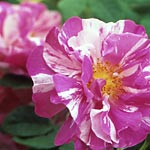
They are generally winter hardy and long lived. They are easy to grow, easy to bloom, and so easy to appreciate. A growing number of modern roses have been bred to emulate the nostalgic style of old garden roses: many-petalled blooms, lavish fragrances, healthy foliage, and tidy growth. As you plan your garden, consider planting some of these hardy shrubs, both old and new. They are so carefree, even first-time gardeners will reap bountiful bouquets.
Old roses are rich in history. Three such roses -- the gallica rose (Rosa gallica), alba rose (R. alba), and damask rose (R. damascena)-- are among the most ancient plants still cultivated. Grown in the Far and Near East during Biblical times, these roses probably were carried to Western Europe by crusaders. "They're romantic," says Judith Gries, a Connecticut gardener. "You can smell the exact same fragrance as the Empress Josephine." All the photos shown were taken in Judith's garden.
continue reading belowFirst, be sure the roses you like will survive winter in your area. Roses will shrug off temperatures down to 20 degrees. If your winter gets colder than that, select the hardiest varieties or protect the rose plants with mulch in winter. In general, old garden roses and modern shrub roses are hardier than hybrid teas and floribundas.
Roses sold in a container of soil can be planted whenever they are available. They are easier to plant than bare-root roses, but can be more expensive. Bare-root roses, planted during their dormant season, offer more selection, because you can buy by mail from specialty firms, such as those listed below.
Get general rose-pruning tips.
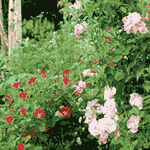
Judith Gries loves to interplant different kinds of roses. In this flower bed, pink Mary Rose and Escapade rub shoulders with red Eye Paint.
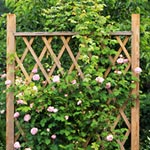
Constance Spry sports a double bloom so full it resembles a peony. This English shrub rose shows no die-back even down to 20 degrees below zero. Constance Spry has only one flush of bloom, but it is a stunner. Its growth is so vigorous that support is helpful.
Whether the rose you're planting is container-grown or bare-root, you must plant it at a depth that's appropriate for your climate. Grafted roses have a gnarled knob, called the bud union, at the base of the trunk. In mild-winter climates, leave the bud union at soil level. Northern gardeners should bury the bud union an inch or two beneath the soil for extra cold protection. If you see no bud union on your rose plant, it's an "own-root" rose; plant it at the same depth it grew in the nursery.
Many growers recommend a balanced fertilizer every four to six weeks during growing season. You can cut back on repeated feedings by applying a slow-release fertilizer in spring. Pruning? Forget it. All that's needed is a gentle shaping after flowering.
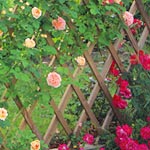
Alchemist and Galway Bay climb a lattice. When blossoms are displayed on high, subtleties of color and flower form become apparent. And, their scents are about nose height, furthering appreciation.
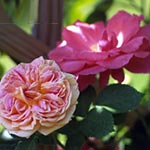
The pink Alchemist is a modern rose, but a full-petalled double that looks old fashioned. This hardy rose is a vigorous climber. The red rose is Galway Bay, a hardy floribunda climber, quite generous of bloom.
Especially Fragrant Roses: Madame Hardy (white flowers); Queen of Denmark or Koenigin von Danemarck (pink); Autumn Damask or Quatre Saisons (pink); Charles Austin (apricot); Gertrude Jekyll (pink).
Roses for Cut Flowers: Charles Austin (apricot flowers); Graham Thomas (yellow); Rosa Mundi (pink and white stripes); Reine Victoria (pink); Buff Beauty (apricot).
Roses for Small Gardens: Gloire de France (pink flowers); Jacques Cartier (pink); Rosa Mundi (pink and white stripes); Souvenir de la malmaison (pink).
Purple Foliage: Rosa glauca or Rosa rubrifolia (pink and white flowers)
Purple Flowers: Reine des Violettes
Hardiest Roses: Rugosa (to -35 degrees); Canadian Explorer (-35); Meidiland (-25); Griffith Buck (-25). Roses that grow on their own roots are not necessarily hardier than their bud-grafted siblings, but if they are winter-killed to the ground they will generally return just fine the next spring
Copyright © www.100flowers.win Botanic Garden All Rights Reserved